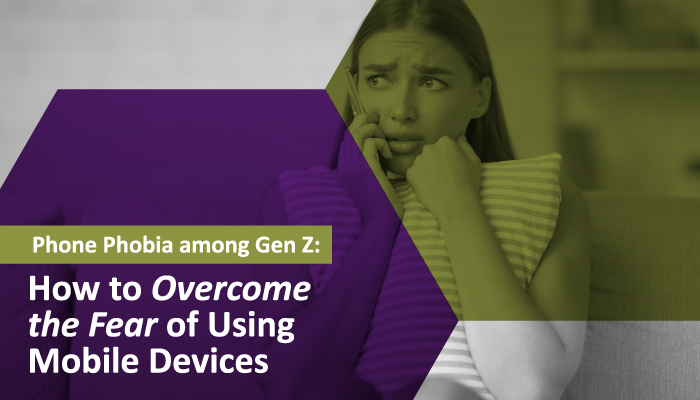
How to manage NOMOPHOBIA (no mobile phone phobia) in the workplace
The term “nomophobia” was coined in 2008 by the UK post office. The term refers to the fear of, or anxiety caused by, not having a working mobile phone. This fear can range from mild anxiety to full-blown panic attacks, and a variety of situations can trigger the anxiety, such as being in an area with poor cellular reception, running out of battery, participating in a “no mobile phone” event or meeting, or losing one’s phone.
People who have Nomophobia are easy to spot. They always have their phone out. Either holding it or having it within hand reach on their desk. In the worst cases, they may glance at the phone every 5-10 seconds. They check their phones in what colleagues may consider inappropriate places, like during a team meeting or when talking with a customer or client. They resist having their camera on during virtual meetings to avoid being “caught” checking their phones multiple times during the session.
While management may view this constant mobile phone checking as a productivity issue, in many cases, the work culture is part of the problem. When employees are asked if they can turn off their phones and ignore texts from colleagues, their typical response is “NO.” The expectation is that they will respond instantaneously to all text inquiries.
Part of the problem is that most organizations do not have policies or criteria for when employees should use a particular communication channel. For example, why and when should someone send a text over email? When should you pick up the phone? Schedule a video meeting.
If you ask most employees why they select a particular communication channel over a different one, chances are they cannot give you a definitive reason. At a minimum, Nomophobia must be addressed on the team and, at best, on the corporate level. It will rarely succeed if left to the individual because the work culture itself is part of the problem.
What can you do?
Step 1: Create clear criteria for the use of various communication channels. For instance, a possible standard for texts is that team members should only send them when an answer is urgent. Otherwise, employees can send their questions via emails or other communication channels. Even if it cuts texting by 50%, this one change can result in less stress and higher productivity.
Step 2: Encourage employees to set their phones to DO NOT DISTURB
While employees need to exercise the Do Not Disturb feature prudently, employees who are under a critical deadline or need time to think without interruptions should be encouraged to use the feature. For the rest of the team, not having immediate access to someone can also have the added benefit of helping team members be more planful.
Chances are, with some planning and foresight, team members could learn to combine three or four different texts into one. It is also a good practice for people to not rely on getting answers to their questions the minute the question pops into their heads.
Another factor is the increasing pressure to be constantly available and connected. With the proliferation of social media and the expectation that people will respond to messages and notifications almost immediately, there is a growing sense that one must always be reachable. This constant pressure to be “on” can contribute to “nomophobia,” as people may feel anxious about the prospect of missing an important message or notification.
Step three: Encourage employees to use “auto-reply” on text messages to alert the sender that they are unavailable and will respond as soon as possible. Provide an estimated time in the auto-reply. If the matter is urgent, the sender should call. These auto-reply messages will go a long way in helping to modify the behavior of both the sender and receiver of messages.
How to Overcome Phone Phobia
If you or someone you know is struggling with phone phobia, there are steps you can take to overcome this fear:
- Identify the root cause of your anxiety. Is it the fear of missing out on social connections? The pressure to be constantly available? Understanding the root cause of your stress can help you address it more effectively.
- Set boundaries for phone use. Determine specific times when you will check your phone and stick to those times. This can help reduce the pressure to be connected and give you a break from the constant notifications.
- Take breaks from your phone. Set aside time each day to disconnect from your phone and spend time in the real world. This can reduce your reliance on your phone and give you a sense of perspective.
- Seek support from friends and family. Talk to someone you trust about your phone phobia and ask for their support in helping you overcome it.
- Consider seeking professional help. If your phone phobia is severe and is causing significant disruption in your life, it may be helpful to seek the guidance of a mental health professional.
In conclusion, managing Nomophobia in the workplace requires a combination of individual and organizational efforts. Creating clear criteria for the use of various communication channels, encouraging the use of the Do Not Disturb feature, and setting auto-reply messages can help modify the behavior of both the sender and receiver of messages. If you or someone you know is struggling with phone phobia, it is essential to identify the root cause of anxiety, set boundaries for phone use, take breaks from the phone, seek support from friends and family, and consider seeking professional help if necessary. Let us take action and make the workplace a healthier and more productive environment by managing Nomophobia.